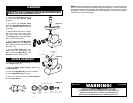
-4- -17-
1
2
3
5
6
4
7
8
9
10
11
12
13
13
14
15
16
17
18
19
20
21
Plastic
Square
Washer
White
Plastic
Washer
Metal
Washer
Auger
Bearing
(2)
Small
Washer
Auger
Screw
TYPES OF SAUSAGE
Most sausages fall into one of four categories: Fresh, Smoked, Cooked or Dried. All
sausages, except dried, require refrigerated storage. There is also a sub-category
of uncooked smoked sausages.
Among the fresh and uncooked smoked sausages, you will nd such avors as
kielbasa or Polish sausage, Italian sausage, breakfast sausage and many others.
Both fresh and uncooked smoked sausages require cooking before eating and also
require refrigerated storage.
Smoked and cooked sausages include salami, bologna, the ever-popular hot dogs
and many others. Proper smoking requires a smokehouse or smoker. These can be
simple home-built structures made from metal drums or even old refrigerators or they
can be elaborate manufactured units. Most smoked sausages are warmed before
serving. Many people think that a smoked sausage will last much longer without
spoilage, but this is not true. Smoked sausages should be treated the same as fresh
sausage in terms of storage.
Dried sausages require the longest processing time, as they are air dried over a long
period of time. Some types of dry sausages are pepperoni, prosciutto and a variety
of ham products, just to name a few. The conditions under which the meat is dried
are very exacting; temperature, time and humidity must all be carefully monitored for
a safe and delicious product.
STORAGE
It is important to remember that sausage will lose its avor the longer that it is stored.
It is recommended that you only make as much sausage as you will need for 4-
6 weeks. Even frozen sausage will begin to lose avor noticeably after 6 weeks.
Frozen sausage should be thawed slowly in the refrigerator before cooking or serving.
Quick thawing of the product will degrade the taste as well.
NEVER operate Grinder without the Tray secured in place.
To avoid serious or fatal injury, NEVER reach into any Grinder inlet.
ALWAYS use the Stomper to push food into the Grinder Head.
Read & fully understand all instructions & warnings prior to use.
WARNING!












